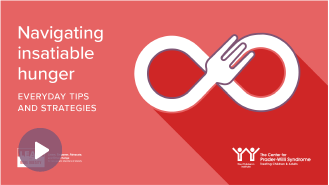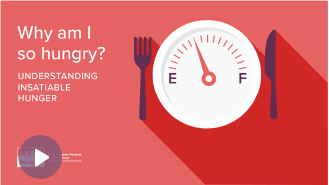Your community, supporting you
If you or someone you know has a rare genetic disease of obesity, most likely the struggles you face are unique. The patient engagement team at Rhythm truly understands that. And we want to help others understand that, too.
Connecting with others in the rare genetic diseases of obesity community to share individual experiences can bring welcomed support.
Check out our video library
Community Stories
Searching for Answers: Molly and Joshua’s Story
Joshua is 3 years old but is the height of a 6 year old and the weight of maybe a 9-10 year old.
Joshua was born a normal weight but he continued gaining weight right from the start. He gained 6 pounds between a 4- and a 6-month checkup and gained about a pound a week thereafter.
MOLLY
Mom of Joshua, living with a suspected rare genetic disorder of obesity
So I started keeping food logs and said, “This is how many calories he’s consuming. Would this amount justify this amount of weight gain that we’re seeing?” And I ended up hearing no.
He’s physically going over to the cabinet and requesting that snack or requesting the bottle or requesting another food item, and that’s happening continually through the day. So we believe that he is just continually feeling hungry.
So then we went into “Who can find answers for us?” mode.
Instinctually you know; we had continued going to the doctors and explaining that something’s just not quite right or different with Joshua than our other 2 children, and we got a lot of fussy baby syndrome, colicky baby syndrome. But that fussiness continued, and that instinct remained in my husband and I that something’s different and he is growing at a rapid rate.
Joshua’s doctors suggested genetic testing
Every time we revisit a doctor or go to a new doctor and hear “We without a doubt believe Joshua has a rare genetic disorder of obesity,” it’s validating, and it reminds us that it’s not our fault. We didn’t do anything to cause this.
The best 2 pieces of advice that I have ever received and will give are number 1: trust your instincts, and 2: don’t be scared to speak up. You are your child’s voice. You know your child best, and you are the one that’s going to step forward and make those choices and make those changes for them.
Rhythm is dedicated to shedding light on rare genetic disorders of obesity
If you suspect that you or someone you know might have a rare genetic disorder of obesity, follow your instincts and talk to a doctor
LEAD for Rare Obesity logo
www.LEADforRareObesity.com
facebook.com/LEADforRareObesity
© 2018 Rhythm Pharmaceuticals. All rights reserved. MC4R-C0088 December 2018.
Joshua & Molly
Listen to Molly share her story of finding answers on behalf of her son, Joshua.
Coping Through the Diagnostic Journey: Karen and Nate’s Story
As soon as you meet him, your face will light up. That’s who he is. Somebody once said that he was joy personified.
Nate has POMC deficiency, which is a rare genetic disorder of obesity.
KAREN
Mom to Nate, living with POMC deficiency, a rare genetic disorder of obesity
His hunger started at 1 week. He cried of hunger.
Karen: “You had dinner.”
It hurt him, and as a parent I couldn’t do anything. I couldn’t fix it.
I remember he was 5, and in 1 day, every 5 minutes, he asked for food, or referenced food, or went to the kitchen to find food. Every 5 minutes of the day.
Finding the diagnosis was a matter of me going to the doctor and saying, “There’s something wrong with my child. Look at his weight, look at his sleeping habits, look at this and this and this—I think there’s something wrong.”
The doctor walked into the room; he said, “It’s genetics, not anything you’ve done; it’s not what you fed him.”
Dealing with that information afterwards, that was difficult, because that was when I was dropped on my island. That was when I was swimming in the dark, not knowing what to do.
Social media is my lifeline. I can help people, and I can get helped in return. I talk about the bad days and the good days.
If you suspect that you or someone you know might have a rare genetic disorder of obesity, follow your instincts and talk to a doctor
I would say, go with your gut feelings. Keep going until you get the answers. You are the parent. You’re the mom, you’re the dad, whatever. You know—you know there’s something. You can feel it. You can see it. You’re with your child. Push. I’m there for them, and I hope they find answers.
Rhythm is working every day to advance the understanding of rare genetic disorders of obesity and to improve the lives of those affected
LEAD for Rare Obesity logo
www.LEADforRareObesity.com
facebook.com/LEADforRareObesity
© 2018 Rhythm Pharmaceuticals. All rights reserved. MC4R-C0089 December 2018.
Nate & Karen
Hear Karen discuss life with Nate, diagnosed with a rare genetic disease of obesity.

Joshua & Molly
Listen to Molly share her story of finding answers on behalf of her son, Joshua.

Searching for Answers: Molly and Joshua’s Story
Joshua is 3 years old but is the height of a 6 year old and the weight of maybe a 9-10 year old.
Joshua was born a normal weight but he continued gaining weight right from the start. He gained 6 pounds between a 4- and a 6-month checkup and gained about a pound a week thereafter.
MOLLY
Mom of Joshua, living with a suspected rare genetic disorder of obesity
So I started keeping food logs and said, “This is how many calories he’s consuming. Would this amount justify this amount of weight gain that we’re seeing?” And I ended up hearing no.
He’s physically going over to the cabinet and requesting that snack or requesting the bottle or requesting another food item, and that’s happening continually through the day. So we believe that he is just continually feeling hungry.
So then we went into “Who can find answers for us?” mode.
Instinctually you know; we had continued going to the doctors and explaining that something’s just not quite right or different with Joshua than our other 2 children, and we got a lot of fussy baby syndrome, colicky baby syndrome. But that fussiness continued, and that instinct remained in my husband and I that something’s different and he is growing at a rapid rate.
Joshua’s doctors suggested genetic testing
Every time we revisit a doctor or go to a new doctor and hear “We without a doubt believe Joshua has a rare genetic disorder of obesity,” it’s validating, and it reminds us that it’s not our fault. We didn’t do anything to cause this.
The best 2 pieces of advice that I have ever received and will give are number 1: trust your instincts, and 2: don’t be scared to speak up. You are your child’s voice. You know your child best, and you are the one that’s going to step forward and make those choices and make those changes for them.
Rhythm is dedicated to shedding light on rare genetic disorders of obesity
If you suspect that you or someone you know might have a rare genetic disorder of obesity, follow your instincts and talk to a doctor
LEAD for Rare Obesity logo
www.LEADforRareObesity.com
facebook.com/LEADforRareObesity
© 2018 Rhythm Pharmaceuticals. All rights reserved. MC4R-C0088 December 2018.

Nate & Karen
Hear Karen discuss life with Nate, diagnosed with a rare genetic disease of obesity.

Coping Through the Diagnostic Journey: Karen and Nate’s Story
As soon as you meet him, your face will light up. That’s who he is. Somebody once said that he was joy personified.
Nate has POMC deficiency, which is a rare genetic disorder of obesity.
KAREN
Mom to Nate, living with POMC deficiency, a rare genetic disorder of obesity
His hunger started at 1 week. He cried of hunger.
Karen: “You had dinner.”
It hurt him, and as a parent I couldn’t do anything. I couldn’t fix it.
I remember he was 5, and in 1 day, every 5 minutes, he asked for food, or referenced food, or went to the kitchen to find food. Every 5 minutes of the day.
Finding the diagnosis was a matter of me going to the doctor and saying, “There’s something wrong with my child. Look at his weight, look at his sleeping habits, look at this and this and this—I think there’s something wrong.”
The doctor walked into the room; he said, “It’s genetics, not anything you’ve done; it’s not what you fed him.”
Dealing with that information afterwards, that was difficult, because that was when I was dropped on my island. That was when I was swimming in the dark, not knowing what to do.
Social media is my lifeline. I can help people, and I can get helped in return. I talk about the bad days and the good days.
If you suspect that you or someone you know might have a rare genetic disorder of obesity, follow your instincts and talk to a doctor
I would say, go with your gut feelings. Keep going until you get the answers. You are the parent. You’re the mom, you’re the dad, whatever. You know—you know there’s something. You can feel it. You can see it. You’re with your child. Push. I’m there for them, and I hope they find answers.
Rhythm is working every day to advance the understanding of rare genetic disorders of obesity and to improve the lives of those affected
LEAD for Rare Obesity logo
www.LEADforRareObesity.com
facebook.com/LEADforRareObesity
© 2018 Rhythm Pharmaceuticals. All rights reserved. MC4R-C0089 December 2018.
Educational Videos
Welcome, and thanks for joining us for Navigating Insatiable Hunger – Everyday Tips and Strategies. My name is Dr. Amy McTighe, and I am the Director of Care Coordination and the Prader-Willi Syndrome Program Manager at the Children’s Institute of Pittsburgh. I’d like to thank Rhythm for asking me to present for this educational series.
Today’s discussion will focus on three key questions: What are food-related behaviors? How do you manage these behaviors? and How do you manage a meltdown? First, some background and context. Rare genetic disorders of obesity prevent your brain from telling your body that you’re full. Specifically, genetic variants in a key part of the brain responsible for controlling hunger (called the MC4R pathway) cause extreme weight gain very early in life and hyperphagia, commonly known as insatiable hunger. There is more to this science, so if you’re interested in learning more about rare genetic disorders of obesity, you may find the website LEADforRareObesity.com to be a helpful resource.
So let’s tackle our first question. What are food-related behaviors of rare genetic disorders of obesity? Common behaviors related to food that I typically see with clients that I work with are focused around three major areas – one being overeating food. This typically means that they are eating food outside of scheduled mealtimes or eating large amounts of food whenever they have access to it. Planned food foraging is also very common. That means that there is a specific plan by the person to obtain food in a large amount whenever someone is not watching. Also, I even see people that eat atypical food, such as raw food, pet food, or frozen foods. Other common behaviors associated with insatiable hunger include engaging in tantrums to obtain food; verbal and physical aggression; arguing or manipulating to get food; sneaking and extensively seeking food; breaking locks on cabinets, refrigerators, or freezers; and shoplifting or stealing food.
Many families struggle with what to do when their child is exhibiting these behaviors. Now let’s talk about how to manage these behaviors.
There are a number of approaches that you can use:
- Total food security or limiting food exposure
- Positive behavior support and verbal praise
- Environmental accommodations and modifications
- Thinking outside the box when managing behaviors
- Preparation
- Predictability
- Schedules and visuals
- And safety plans
There’s a lot we could explore in each of these, but in the interest of time I will highlight a few in greater detail.
I have a child that I’m working with that hoards wrappers from food that she has obtained from family members, friends, or on the bus, in her bedroom. We had to put supports in place for that family in order to make sure that the extra food outside of the scheduled meal was not being obtained. Using a lock can be a helpful tool in managing food-related behaviors.
Locks and/or alarms should be used so food cannot be accessed. I know it may seem cruel, but it can actually be a useful tool that is for the benefit of the individual. Locks and alarms are safety measures to prevent binge eating, prevent extraordinary weight gain, and decrease anxiety and guilt that food can be obtained. You may wonder when you should consider using locks. Here are a few helpful tips:
- There is never an age requirement where locks should be applied.
- Always, a best practice is to lock for safety.
If you’re thinking about using locks, consider the following:
- Increased preoccupation with food.
- Increased food-seeking behaviors.
- Unexplainable weight gain.
- Food is missing.
- Or the person tells you that he or she is taking food.
We also talked about the importance of preparation and predictability. A structured meal is an important part of this. Let’s talk about some helpful tips:
- Establish a meal pattern immediately.
- Post a daily or weekly menu.
- No serving bowls at the table. This means that you are not participating in a family-style meal.
- No participation in meal preparation and cleanup.
- Use disposable containers to make the meal look bigger.
Posting a daily or weekly menu may vary based on your child’s level of food anxiety. Some children are able to handle one day’s worth of meals, and others are able to see the entire week’s worth of meals that are planned.
Even with our best planning, meltdowns will happen. First, please understand that there are times that you are just going to let the meltdown run its course, but let’s also talk about some other helpful tips to manage meltdowns. Managing a meltdown can be difficult. Here are some basic skills that I give to families in order to manage meltdowns more effectively:
- Remain calm. Think before you speak, speak in a calm voice, and try not to show fear, anger, or frustration.
- Validate the emotion. You may say something like, “I can see you’re upset about what is happening,” or “I can see you’re anxious, how can I help you?”
- Suggest coping strategies. Slow counting and deep slow breathing are often effective.
- Redirect in a calm, firm voice. “Would you like to work on a puzzle or play a game?”
- Guide your child through the problem-solving process. For example, you may say something like, “We don’t have soda, but we could drink hot tea or lemonade. Which one would you like?”
There will be times when meltdowns will escalate. Let’s talk about a few things that will help in these situations:
- Never give in to unreasonable demands.
- Keep yourself out of harm’s way. Move dangerous objects away and seek assistance from others as needed.
- If yelling is happening, refuse to speak. Praise the child when they are speaking in a calm voice and redirect them.
- Give your child time and space to calm down. You may even want to retreat to a designated area until calm.
- Move past the episode to avoid reigniting the anger or frustration.
Move past the episode means move past the episode. Do not punish your child. Do not talk about it the next day. It’s really not their fault. They have a rare genetic disease. Remember that food security promotes improved physical and mental health. A concept adopted by Dr. Gourash and Dr. Forster of the Pittsburgh Partnership includes “no doubt, no hope, and no disappointment.” No doubt means you are creating an environment where there is no doubt when the next meal will be served. No hope means that there is no ability to obtain unauthorized food, and no disappointment means that unauthorized food is not available.
I hope you found this session to be helpful. You can find more about my work at the Children’s Institute of Pittsburgh by visiting amazingkids.org.
For more videos like this, don’t forget to check back on the Lead for Rare Obesity Facebook page and LEADforRareObesity.com.
LEAD for Rare Obesity is an initiative of Rhythm Pharmaceuticals, Inc.
© 2019 Rhythm Pharmaceuticals, Inc. All rights reserved. MC4R-C0282-10.2019
Navigating insatiable hunger
Explore common behaviors caused by insatiable hunger and everyday strategies to help manage them.
Welcome, and thanks for joining us for “Why am I so hungry? Understanding insatiable hunger.” I’m Jill Garrison, and I’m on the Medical Affairs team at Rhythm Pharmaceuticals. Rhythm is a small biopharmaceutical company that was founded in 2008, and is located in Boston, Massachusetts. At Rhythm, we’re dedicated to transforming the care of individuals living with rare genetic disorders of obesity.
My personal background is in scientific research. I earned my Ph.D. in nutritional and metabolic biology, and for the past 15-plus years, I’ve been studying how the brain regulates body weight and our metabolism. And related to this, I have studied how there are many different factors that can disrupt this body weight regulation and ultimately lead to obesity and its related health consequences.
There are many different rare genetic disorders of obesity, and they present in many different ways, but they often present with two common symptoms: severe obesity that occurs early in life, also known as early-onset obesity, and a feeling of insatiable hunger, also known as hyperphagia.
Today, we’re going to take a closer look at why this happens in individuals with rare genetic disorders of obesity. We’ll take a look at what insatiable hunger looks and feels like, how hunger works in our bodies, and what happens in someone with a rare genetic disorder of obesity.
Let’s take a closer look at insatiable hunger. Insatiable hunger, or hyperphagia, is different than regular hunger. Insatiable hunger is a deep hunger that doesn’t go away. It feels like your body is always hungry, and your hunger is stuck in the “on” position. And because of this, it can make it difficult to focus, because you are constantly consumed by the desire to eat. One mom describes what this is like for her son:
“His hunger started at one week. He cried of hunger all the time. He hurt. He will live his whole life hungry. Hunger controls him.”
While different in each person, insatiable hunger often causes:
- Intense hunger that doesn’t go away
- Taking a longer time to feel full while eating
- Feeling hungry again right after a meal
- Thinking about food constantly
- Becoming very upset when food is unavailable
- Always looking for food. For example, this could include stealing food, waking up at night to find food, or even eating food others leave behind, or from the trash.
The feeling of insatiable hunger can be overwhelming. Another mom describes it:
“My daughter has told me, ‘I know you are going to feed me, but it’s like I’m battling with my mind.’ It’s a struggle.”
So what causes insatiable hunger? To understand the science behind it, let’s take a look at what hunger looks like in all of our bodies. Simply put, we need energy to live. Our bodies need fuel in order to go about our daily lives, in order to perform the functions it needs to stay alive. And we get this energy, we get this fuel from food. So our body has many systems in place to make sure that we consume the right amount of food, the right amount of energy, to go about and live our daily lives.
And when this system is functioning properly, when we are eating as much energy as we are using it to live our lives, this system is in balance, and our body weight stays stable. It stays in balance. When we eat too much food, when we eat more food than our body actually uses in its daily lives, our bodies end up storing this energy as fat tissue, and this is when weight gain occurs. Now, the opposite is also true. If we eat too little food, if we don’t eat enough energy, we don’t have the fuel our body needs to go about and live our daily lives.
Our bodies have natural checks and balances to make sure this balance stays even. We have triggers in our body that tell us when to start eating and when to stop, and hormones act as the messengers.
Now, let’s take a closer look at what we can call the “I’m hungry” cycle. Now, imagine an empty stomach with no food in it – basically, representing a body that is low on energy and needs fuel. When this happens, hormones from the body report this low status to the brain, sending the message of, “I’m empty. Eat something.” The brain gets this message, and in turn releases a protein to stimulate the appetite.
The opposite also occurs when we have the “I’m full” cycle. Once there is food in the stomach, representing a body that has enough energy, a message is sent to the brain, telling it, “I’m full. Stop eating. The brain then goes ahead and dials down that protein that stimulated the appetite, and cranks up the one that is an appetite suppressant, so that the person stops eating.
So how do our brains make sense of all these messages telling it to eat something, or stop eating? How does it know when to send those appetite-stimulating or -suppressing signals? The specific part of our brain that accepts these messages and makes sense of them is called the hypothalamus. Think of the hypothalamus as a neighborhood within the brain. In this neighborhood, there is a road called the MC4R pathway. On this road, cars travel, carrying news and information to and from the brain.
These cars on the MC4R pathway are proteins and hormones that communicate with each other to control hunger and regulate our energy balance. In individuals with a rare genetic disorder of obesity, this process does not work as it should. A genetic variant, or a change in the body’s DNA, causes part of this pathway to not work properly. Think of one of the roads as blocked, and the cars can’t get through. When this happens, the signals in the hypothalamus get stuck in the “I’m hungry” cycle, because the “I’m full” message cannot get through and be delivered.
The brain doesn’t get this message and believes that the body is starving, even though there is food in the stomach. Without this message or signal, this can cause insatiable hunger, and ultimately lead to extreme weight gain.
So, to recap, rare genetic disorders of obesity may be caused when the MC4R pathway in the brain isn’t working properly. In this case, our brain instructs our body to keep eating, even if we already have just eaten. When this happens, it can lead to severe obesity early in life, and insatiable hunger.
I hope you found this helpful. If you suspect you have a rare genetic disorder of obesity, or know someone who does, we encourage you to check out our LEAD website, at LEADforRareObesity.com, for additional resources. Here you can sign up to receive updates, or find helpful tools, such as a doctor discussion guide, or information about our genetic testing program. This video is one of a series, and so we hope you’ll check back on Facebook again to find when the next video posts.
Thanks for watching.
LEAD for Rare Obesity is an initiative of Rhythm Pharmaceuticals, Inc.
© 2019 Rhythm Pharmaceuticals, Inc. All rights reserved. MC4R-C0282-10.2019
Why am I so hungry?

Navigating insatiable hunger
Explore common behaviors caused by insatiable hunger and everyday strategies to help manage them.

Welcome, and thanks for joining us for Navigating Insatiable Hunger – Everyday Tips and Strategies. My name is Dr. Amy McTighe, and I am the Director of Care Coordination and the Prader-Willi Syndrome Program Manager at the Children’s Institute of Pittsburgh. I’d like to thank Rhythm for asking me to present for this educational series.
Today’s discussion will focus on three key questions: What are food-related behaviors? How do you manage these behaviors? and How do you manage a meltdown? First, some background and context. Rare genetic disorders of obesity prevent your brain from telling your body that you’re full. Specifically, genetic variants in a key part of the brain responsible for controlling hunger (called the MC4R pathway) cause extreme weight gain very early in life and hyperphagia, commonly known as insatiable hunger. There is more to this science, so if you’re interested in learning more about rare genetic disorders of obesity, you may find the website LEADforRareObesity.com to be a helpful resource.
So let’s tackle our first question. What are food-related behaviors of rare genetic disorders of obesity? Common behaviors related to food that I typically see with clients that I work with are focused around three major areas – one being overeating food. This typically means that they are eating food outside of scheduled mealtimes or eating large amounts of food whenever they have access to it. Planned food foraging is also very common. That means that there is a specific plan by the person to obtain food in a large amount whenever someone is not watching. Also, I even see people that eat atypical food, such as raw food, pet food, or frozen foods. Other common behaviors associated with insatiable hunger include engaging in tantrums to obtain food; verbal and physical aggression; arguing or manipulating to get food; sneaking and extensively seeking food; breaking locks on cabinets, refrigerators, or freezers; and shoplifting or stealing food.
Many families struggle with what to do when their child is exhibiting these behaviors. Now let’s talk about how to manage these behaviors.
There are a number of approaches that you can use:
- Total food security or limiting food exposure
- Positive behavior support and verbal praise
- Environmental accommodations and modifications
- Thinking outside the box when managing behaviors
- Preparation
- Predictability
- Schedules and visuals
- And safety plans
There’s a lot we could explore in each of these, but in the interest of time I will highlight a few in greater detail.
I have a child that I’m working with that hoards wrappers from food that she has obtained from family members, friends, or on the bus, in her bedroom. We had to put supports in place for that family in order to make sure that the extra food outside of the scheduled meal was not being obtained. Using a lock can be a helpful tool in managing food-related behaviors.
Locks and/or alarms should be used so food cannot be accessed. I know it may seem cruel, but it can actually be a useful tool that is for the benefit of the individual. Locks and alarms are safety measures to prevent binge eating, prevent extraordinary weight gain, and decrease anxiety and guilt that food can be obtained. You may wonder when you should consider using locks. Here are a few helpful tips:
- There is never an age requirement where locks should be applied.
- Always, a best practice is to lock for safety.
If you’re thinking about using locks, consider the following:
- Increased preoccupation with food.
- Increased food-seeking behaviors.
- Unexplainable weight gain.
- Food is missing.
- Or the person tells you that he or she is taking food.
We also talked about the importance of preparation and predictability. A structured meal is an important part of this. Let’s talk about some helpful tips:
- Establish a meal pattern immediately.
- Post a daily or weekly menu.
- No serving bowls at the table. This means that you are not participating in a family-style meal.
- No participation in meal preparation and cleanup.
- Use disposable containers to make the meal look bigger.
Posting a daily or weekly menu may vary based on your child’s level of food anxiety. Some children are able to handle one day’s worth of meals, and others are able to see the entire week’s worth of meals that are planned.
Even with our best planning, meltdowns will happen. First, please understand that there are times that you are just going to let the meltdown run its course, but let’s also talk about some other helpful tips to manage meltdowns. Managing a meltdown can be difficult. Here are some basic skills that I give to families in order to manage meltdowns more effectively:
- Remain calm. Think before you speak, speak in a calm voice, and try not to show fear, anger, or frustration.
- Validate the emotion. You may say something like, “I can see you’re upset about what is happening,” or “I can see you’re anxious, how can I help you?”
- Suggest coping strategies. Slow counting and deep slow breathing are often effective.
- Redirect in a calm, firm voice. “Would you like to work on a puzzle or play a game?”
- Guide your child through the problem-solving process. For example, you may say something like, “We don’t have soda, but we could drink hot tea or lemonade. Which one would you like?”
There will be times when meltdowns will escalate. Let’s talk about a few things that will help in these situations:
- Never give in to unreasonable demands.
- Keep yourself out of harm’s way. Move dangerous objects away and seek assistance from others as needed.
- If yelling is happening, refuse to speak. Praise the child when they are speaking in a calm voice and redirect them.
- Give your child time and space to calm down. You may even want to retreat to a designated area until calm.
- Move past the episode to avoid reigniting the anger or frustration.
Move past the episode means move past the episode. Do not punish your child. Do not talk about it the next day. It’s really not their fault. They have a rare genetic disease. Remember that food security promotes improved physical and mental health. A concept adopted by Dr. Gourash and Dr. Forster of the Pittsburgh Partnership includes “no doubt, no hope, and no disappointment.” No doubt means you are creating an environment where there is no doubt when the next meal will be served. No hope means that there is no ability to obtain unauthorized food, and no disappointment means that unauthorized food is not available.
I hope you found this session to be helpful. You can find more about my work at the Children’s Institute of Pittsburgh by visiting amazingkids.org.
For more videos like this, don’t forget to check back on the Lead for Rare Obesity Facebook page and LEADforRareObesity.com.
LEAD for Rare Obesity is an initiative of Rhythm Pharmaceuticals, Inc.
© 2019 Rhythm Pharmaceuticals, Inc. All rights reserved. MC4R-C0282-10.2019

Why am I so hungry?
In this video we'll explore the science behind insatiable hunger, including different ways of identifying it.

Welcome, and thanks for joining us for “Why am I so hungry? Understanding insatiable hunger.” I’m Jill Garrison, and I’m on the Medical Affairs team at Rhythm Pharmaceuticals. Rhythm is a small biopharmaceutical company that was founded in 2008, and is located in Boston, Massachusetts. At Rhythm, we’re dedicated to transforming the care of individuals living with rare genetic disorders of obesity.
My personal background is in scientific research. I earned my Ph.D. in nutritional and metabolic biology, and for the past 15-plus years, I’ve been studying how the brain regulates body weight and our metabolism. And related to this, I have studied how there are many different factors that can disrupt this body weight regulation and ultimately lead to obesity and its related health consequences.
There are many different rare genetic disorders of obesity, and they present in many different ways, but they often present with two common symptoms: severe obesity that occurs early in life, also known as early-onset obesity, and a feeling of insatiable hunger, also known as hyperphagia.
Today, we’re going to take a closer look at why this happens in individuals with rare genetic disorders of obesity. We’ll take a look at what insatiable hunger looks and feels like, how hunger works in our bodies, and what happens in someone with a rare genetic disorder of obesity.
Let’s take a closer look at insatiable hunger. Insatiable hunger, or hyperphagia, is different than regular hunger. Insatiable hunger is a deep hunger that doesn’t go away. It feels like your body is always hungry, and your hunger is stuck in the “on” position. And because of this, it can make it difficult to focus, because you are constantly consumed by the desire to eat. One mom describes what this is like for her son:
“His hunger started at one week. He cried of hunger all the time. He hurt. He will live his whole life hungry. Hunger controls him.”
While different in each person, insatiable hunger often causes:
- Intense hunger that doesn’t go away
- Taking a longer time to feel full while eating
- Feeling hungry again right after a meal
- Thinking about food constantly
- Becoming very upset when food is unavailable
- Always looking for food. For example, this could include stealing food, waking up at night to find food, or even eating food others leave behind, or from the trash.
The feeling of insatiable hunger can be overwhelming. Another mom describes it:
“My daughter has told me, ‘I know you are going to feed me, but it’s like I’m battling with my mind.’ It’s a struggle.”
So what causes insatiable hunger? To understand the science behind it, let’s take a look at what hunger looks like in all of our bodies. Simply put, we need energy to live. Our bodies need fuel in order to go about our daily lives, in order to perform the functions it needs to stay alive. And we get this energy, we get this fuel from food. So our body has many systems in place to make sure that we consume the right amount of food, the right amount of energy, to go about and live our daily lives.
And when this system is functioning properly, when we are eating as much energy as we are using it to live our lives, this system is in balance, and our body weight stays stable. It stays in balance. When we eat too much food, when we eat more food than our body actually uses in its daily lives, our bodies end up storing this energy as fat tissue, and this is when weight gain occurs. Now, the opposite is also true. If we eat too little food, if we don’t eat enough energy, we don’t have the fuel our body needs to go about and live our daily lives.
Our bodies have natural checks and balances to make sure this balance stays even. We have triggers in our body that tell us when to start eating and when to stop, and hormones act as the messengers.
Now, let’s take a closer look at what we can call the “I’m hungry” cycle. Now, imagine an empty stomach with no food in it – basically, representing a body that is low on energy and needs fuel. When this happens, hormones from the body report this low status to the brain, sending the message of, “I’m empty. Eat something.” The brain gets this message, and in turn releases a protein to stimulate the appetite.
The opposite also occurs when we have the “I’m full” cycle. Once there is food in the stomach, representing a body that has enough energy, a message is sent to the brain, telling it, “I’m full. Stop eating. The brain then goes ahead and dials down that protein that stimulated the appetite, and cranks up the one that is an appetite suppressant, so that the person stops eating.
So how do our brains make sense of all these messages telling it to eat something, or stop eating? How does it know when to send those appetite-stimulating or -suppressing signals? The specific part of our brain that accepts these messages and makes sense of them is called the hypothalamus. Think of the hypothalamus as a neighborhood within the brain. In this neighborhood, there is a road called the MC4R pathway. On this road, cars travel, carrying news and information to and from the brain.
These cars on the MC4R pathway are proteins and hormones that communicate with each other to control hunger and regulate our energy balance. In individuals with a rare genetic disorder of obesity, this process does not work as it should. A genetic variant, or a change in the body’s DNA, causes part of this pathway to not work properly. Think of one of the roads as blocked, and the cars can’t get through. When this happens, the signals in the hypothalamus get stuck in the “I’m hungry” cycle, because the “I’m full” message cannot get through and be delivered.
The brain doesn’t get this message and believes that the body is starving, even though there is food in the stomach. Without this message or signal, this can cause insatiable hunger, and ultimately lead to extreme weight gain.
So, to recap, rare genetic disorders of obesity may be caused when the MC4R pathway in the brain isn’t working properly. In this case, our brain instructs our body to keep eating, even if we already have just eaten. When this happens, it can lead to severe obesity early in life, and insatiable hunger.
I hope you found this helpful. If you suspect you have a rare genetic disorder of obesity, or know someone who does, we encourage you to check out our LEAD website, at LEADforRareObesity.com, for additional resources. Here you can sign up to receive updates, or find helpful tools, such as a doctor discussion guide, or information about our genetic testing program. This video is one of a series, and so we hope you’ll check back on Facebook again to find when the next video posts.
Thanks for watching.
LEAD for Rare Obesity is an initiative of Rhythm Pharmaceuticals, Inc.
© 2019 Rhythm Pharmaceuticals, Inc. All rights reserved. MC4R-C0282-10.2019


Do you have an experience living with a rare genetic disease of obesity? Share your story or a tip—it’s a great way to guide and inspire others.

Print a discussion guide to help you talk to your doctor about your concerns about rare genetic diseases of obesity.


